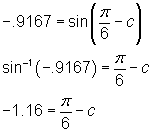Real-World Application Using the Sine Function
The table below shows the number of daylight hours on the fifteenth of every month in Center City, where t = 1 represents January 15th, t = 2 represents February 15th, t = 3 represents March 15th, and so on.
| Month | t | Hours of Daylight |
| Jan | 1 | 10.67 |
| Feb | 2 | 11.45 |
| Mar | 3 | 11.97 |
| Apr | 4 | 12.75 |
| May | 5 | 13.42 |
| June | 6 | 13.89 |
| July | 7 | 13.67 |
| Aug | 8 | 13.09 |
| Sept | 9 | 12.34 |
| Oct | 10 | 11.62 |
| Nov | 11 | 10.92 |
| Dec | 12 | 10.53 |
Write a function that models the number of hours of daylight for Center City. Then use your model to determine the number of hours of daylight on May 30th.
Procedure:
1. Find the values of A, h
2. Compute c by substituting one of the coordinate pairs into the function.
3. Use the function to solve the problem.
Solution:
The value of A is one-half the difference between the most daylight (13.89 hours) and the least daylight (10.53 hours).

The value of h is one-half the sum of the greatest value and the least value.

Since you know the period is 12 months, you can find k.

Substitute these values into the general form of the sinusoidal function.

To compute c, substitute one of the coordinate pairs, (t, y), into the function. Use the pair (1, 10.67) to substitute in t = 1 and y = 10.67.

Subtract 12.21 from both sides:

Divide both sides by 1.68:

To continue solving for c, remember that π is equal to approximately 3.14.

The function  is a model for the hours of daylight in Center City.
is a model for the hours of daylight in Center City.
Next, you will determine the number of hours of daylight in Center City on May 30th using the function above.